Looking for ways to balance usability, innovation, and business performance?
Let’s discuss the options.
Published: 11 February, 2025 · 9 mins read
Learn everything you need to know about developing a market-leading property listing platform. We discuss common real estate challenges and how listing platforms solve them, providing advanced property search, management, mapping, and analytics. Step-by-step, we walk you through each stage of property listing platform development, highlight the most popular features and integrations, and discuss key focus areas.
Property listing portals help businesses reach broader customer audiences and increase conversions through functionality and convenience. Meanwhile, these solutions are not the easiest to design and implement. Development can come with a number of challenges, including accessibility, fast-paced tech development, performance, user demographics, and more. Partnering with Exoft will ensure these and other particularities will be accounted for, and you’ll get a digital platform that strengthens your business.
Thoughtful property listing portal development can ensure a steady flow of customers.
Forty-one percent of recent homeowners
started their buying process
by looking at properties for sale online. People are looking for photos, detailed property
information, and floor plans, among other things.
Meanwhile, a property portal can quickly fail due to a complex interface, poor performance,
or other issues that are actually easy to prevent. This guide explains how to create a property
listing website. You’ll find practical information on:
Partnering with the right development team mitigates common risks. Yet, even if you decide to handle everything independently, you’ll find actionable recommendations to rely on when building your own property listing portal.
The easiest way to design a property listing website that drives business results is to analyze what already works. Look at common features on popular websites. Assess their logic and mechanics. Estimate the intuitiveness and visual implementation. After performing such an analysis, you will have a rough draft of the site structure and notes on the preferred design.

“Success in property portal development comes down to understanding user behavior patterns
and implementing features that directly address customer needs. We’ve started by studying
platforms like Zillow and Realtor.com to identify what truly drives user engagement. And
we keep monitoring the market to stay aware of the trends.”
Every feature in a property listing website should serve a purpose. It can be improving user
engagement, simplifying navigation, driving conversions, or something else. Our experience
shows that balancing functionality with simplicity is key to long-term success. If we are to
summarize the core property listing portal features, the list will look like this:
| Feature Type | Feature Name | Definition | Example | Challenges Faced |
|---|---|---|---|---|
| Search and Filtering | Advanced Search Options | Enables users to search by location, price, property type, and amenities | Zillow’s search bar | Handling complex queries without slowing performance or overwhelming users with too many options |
| Property Listings | Listing Management | Allows users to submit, categorize, and manage property listings | Realtor.com | Ensuring accurate categorization and maintaining an intuitive submission and approval process |
| Map Integration | Interactive Maps | Uses APIs like Google Maps to provide property visualization and geolocation | Google Maps API | Managing API costs and ensuring seamless integration for accurate property mapping |
| Responsive Design | Multi-Device Compatibility | Ensures smooth functionality across mobile, tablet, and desktop devices | Airbnb | Balancing fast load times with high-quality visuals on all devices |
| User Profiles and Dashboards | Personalized Dashboards | Provides buyers, sellers, and agents with features like saved searches and property tracking | Realtor.com | Maintaining user-friendly dashboards while offering robust customization options |
| Property Analytics | Real-Time Insights | Tracks property views, inquiries, and performance metrics for owners/agents | Realtor.com | Collecting and visualizing large volumes of data in real-time without slowing down the platform |
Let’s discuss the options.
Building a large-scale application isn’t a piece of cake. It’s critical to know what complexities you may face during property listing portal software development to navigate the process efficiently.
Property listings rely on information from fragmented sources rather than centralized data repositories. It calls for sophisticated integration strategies. Technical teams must develop robust middleware that can standardize these data. It involves creating sophisticated ETL pipelines (Extract, Transform, Load) that can:
That’s the only way to create a helpful and well-performing data ecosystem.
The rapid evolution of technology demands constant adaptation in real estate portal development. Technologies like AI and ML offer transformative potential but also complicate implementation. Key technological considerations include:
The safest way to handle this is to build flexible technological frameworks. Create modular and easily upgradable systems compatible with multiple integrations and emerging technologies.

Home listing platforms must serve a diverse customer base. It demands a nuanced approach
to user interface and experience design. This will most likely require thorough customer
research, usability testing, and context-aware personalization.
Critical UX considerations include:
Businesses need to create engaging and compelling experiences to withstand the competition. Our management mobile app case study proves it’s possible even for the most tricky requests.
Real estate platforms handle sensitive personal and financial information. Hence, robust security measures are a fundamental requirement. The basic security setup should include:
Security must be an ongoing commitment. Your dedicated web developers should conduct regular assessments and update the incident response plan accordingly. This is essential for maintaining the trust of your buyers and protecting your business.
In addition to complex, high-volume data operations, property listing platforms deal with high concurrent user loads and rapid content updates. Meanwhile, customers expect exceptional performance across various devices and network conditions. This calls for thoughtful performance optimization, such as:
It lets you create an application that can handle thousands of concurrent users and process complex search queries in milliseconds.
Preparing for the challenges described above will make you ready for the launch. But it may not be enough to exploit the full potential of your business idea. Several things can help you build a property listing website with a promise to overperform:
Chatbots have emerged as a game-changing technology for property listing portals. They are simple-to-implement tools that offer unprecedented levels of user interaction and support. Modern chatbots can:
Chatbots not only improve user satisfaction but also free up human agents to handle more complex interactions.

Data integration defines the portal’s success to a great extent. It’s essential to use the method that suits your strategy best. You can scale data sourcing with time by adding more methods. We’d suggest starting with these options:
| Data Source | Description | Pros | Cons | Best For |
|---|---|---|---|---|
| MLS Integration | Direct feed from Multiple Listing Services | Real-time updates Verified data |
Complex integration Regional limitations |
Large-scale platforms |
| Direct Agent Input | Manual listing creation by agents | Exclusive listings Direct control |
Time-intensive Quality variance |
Small-medium portals |
| API Aggregators | Third-party data providers | Wide coverage Structured data |
Additional costs Dependency risks |
Quick market entry |
| Web Scraping | Automated data collection | Comprehensive data Low cost |
Legal considerations Data accuracy |
Market research |
AI and ML
are still advanced technologies rather than commonplace ones. However, they are changing quickly.
Smart algorithms enable a whole new level of accuracy in property matching and personalization.
They improve everything from filtering to analytics and strategic planning.
“Many real estate platforms hesitate to implement AI due to perceived complexity and cost.
However, our projects show that AI significantly reduces property matching time and increases
lead conversion through better recommendations.”
The upcoming recommendations are based on our own experience with property listing portal
development. Some of these tips might seem obvious. But it’s simple things we tend to
overlook when dealing with complex tasks and platforms.
“Our development philosophy centers on three core principles: performance, scalability, and
user experience. We’ve found that focusing on these areas from day one leads to sustainable
growth and higher user satisfaction.”

In addition to already mentioned security and user experience above, we suggest focusing on the following:
Let’s take a closer look at how each helps you shape a competitive digital platform.
Site speed is more than a technical metric. It’s a critical business performance indicator
– a silent conversion driver if you wish.
The probability of bounce increases by 32% as page load time goes from one second to three
seconds. For property listing platforms, this translates directly into lost leads and missed
opportunities. The good news is there are proven strategies for speed optimization:

Build software for every device. Responsiveness is not just one of those capricious app
designing trends to know. Being supported by a maximum range of devices expands your
audience accordingly, especially given the growing share of mobile traffic every year.
A truly responsive design goes beyond simple screen scaling. It requires a comprehensive approach
to user experience across devices. Some critical considerations are:
Search features are the most effective mechanism to demonstrate the relevance of your
custom property listing portal solution. They can dramatically improve user engagement.
Platforms with intelligent and fast search functions see higher user retention rates
simply thanks to the ability to display relevant results and offer suggestions.
To improve the performance in this area, you can implement:
In a broader sense, performance covers both traffic-related and business aspects. Hence,
continuous monitoring and iteration are crucial for maintaining competitive advantage. And
it’s an ongoing process.
It’s essential to distinguish the metrics that matter for your company specifically. As for
the means, some recommended monitoring approaches are:
Create a property listing website that is inclusive and accommodates the needs of all
users. On the one hand, it’s required by the government and local regulations. On the
other hand, it expands your potential user base. In both cases, accessible design
demonstrates your company’s social responsibility.
It’s best to use Web Content Accessibility Guidelines (WCAG) during platform design and planning.
Examples of some core accessibility implementations include:
Looking for an experienced and reliable development team? We have delivered dozens of software projects that drive exceptional results.
Developing a successful custom property listing portal requires a strategic approach. The
journey from initial idea to market-ready solution involves careful planning, technical
expertise, and a deep understanding of both user needs and technological capabilities.
The step-by-step web or desktop app development process includes:

When building property listing portals, focus on the aspects that make any digital
solution worth using. Those include rich functionality, site speed, and a responsive
website, among other things. Keep them in mind at each step of the development process.
What if development still seems too much? It’s completely normal. If you are not certain about
specific development aspects or choices, it’s best to rely on expert
real estate development services. We’ll be glad to discuss the details whenever you are ready. Contact our team for
deeper insights and a tailored development plan.
It depends on your requirements. You can build a property listing website at $1,000 using a little template-based solution. Basic custom websites typically cost between $10,000 and $20,000. The average price for a classic property portal is around $50,000. It’s essential for us to know more about your requirements to provide more specifics.
A basic portal takes 3-4 months to develop. Platforms with more advanced capabilities typically require 6-8 months. It depends on the number of features you want for a launch, resource availability, etc. It’s best to design a property listing website using an iterative approach, launching with a minimal feature set and expanding it gradually.
The tech stack for web apps development can vary based on many factors. One way to build property listing portal from scratch is by using Node.js/Python for the backend, React for the frontend, Elasticsearch for search, and AWS/Azure for cloud infrastructure. These provide optimal performance and scalability. Still, it’s one of several appropriate technology mixes.
We build with scalability in mind. We rely on microservices architecture, cloud-native solutions, and containerization from the start. We also implement load balancing and caching to handle increased traffic and support stable performance during peak hours or periods. This allows for easy scaling and feature addition as needed.
We typically combine MLS integration, direct agent inputs, and verified third-party APIs. This multi-source approach ensures comprehensive and accurate listing data while maintaining reliability. You may also need local government and public data for property records, zoning information, etc.